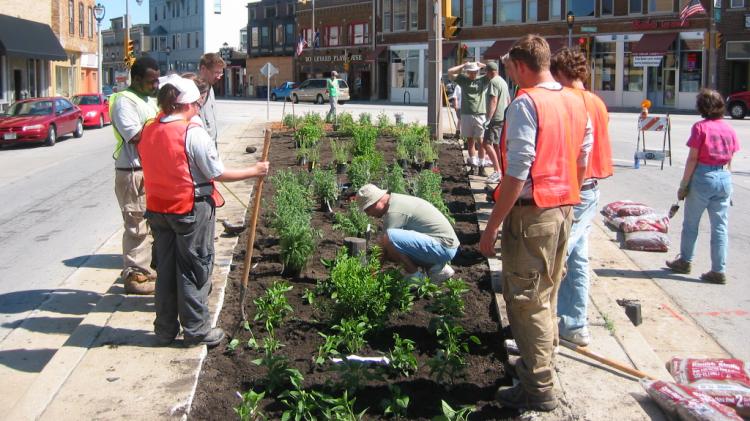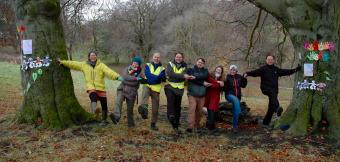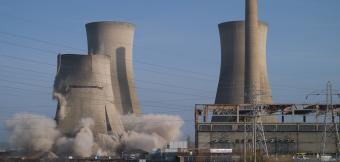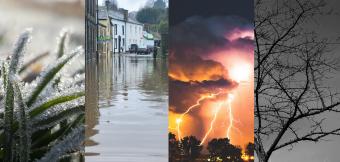
Campaign for local adaptation
Wildfires, hurricanes, floods, droughts and heatwaves occur at landscape level, so it’s important to align adaptations made by individuals, communities and government. Work with your community to find what adaptation plans exist, ensure they're adequate and funded, and educate and mobilise locals.

Before you can campaign for coordinated local adaptation, you need to get a clear idea of the threats to your community. Action 3: 'Assess your climate risks' sets out how you can do this and links to some useful assessment resources. You should also look for existing climate action groups near where you live (Action 37: 'Join a climate action group'), and find out what action is already being taken by local government and other statutory agencies like the water board.
Having assessed the risks your community faces and established what adaptation is already underway, you have two choices. If you feel that existing adaptation strategies are adequate then design your own adaptations to fit into that strategy and encourage others to do the same; maybe even apply for grant funding. If existing adaptation strategies are not adequate, you need to come together with like-minded neighbours to campaign for increased local action.
The key goal of local adaptation is increased community resilience. The United Nations International Strategy for Disaster Reduction (UN-ISDR) defines resilience as the ability of a system, community or society exposed to hazards to resist, absorb, accommodate to and recover from the effects of a hazard in a timely and efficient manner.
When a disaster occurs, a resilient community will be able to:
-
sustain a functioning community system, including power, water, health and education provision
-
reduce the negative effects of hazards on people, property and systems, before, during and after the disaster
-
recover from the hazard in a timely and efficient manner
-
learn from experience and 'build back better'.
There is no ‘one-size fits all’ approach for communities to anticipate, plan, and adapt to the changing climate. Projected climate impacts will differ in every region. Local awareness of climate change vulnerabilities differ. Financial and technical resources to assess and adapt vary. A variety of processes and approaches are available to help communities understand their climate change vulnerabilities and take action. You'll have to work out the best approach with your community and local authorities. But here are three great examples which may inspire you.
The Belford Catchment Management Scheme protects a village in Northumberland, UK, with a long history of flooding. In July 2007 a large flood occurred and the villagers had had enough. A partnership project between the Environment Agency, Newcastle University and local landowners designed run-off management features costing 10% of a conventional defence scheme. 26 interventions that trap sediment, improve water quality, create new ecological zones and slow water flow successfully held water upstream during the next flood. This is an effective, small-scale, sustainable and community –level approach which can help reduce flood risk elsewhere at a fraction of the cost, time and effort.
Adelaide Climate Ready Champions is a project of The Australian Red Cross, in partnership with Adelaide’s Resilient South councils, to help communities prepare for extreme climate events. The community champions are trained to support others to become ‘climate ready’, given practical guidance to deliver activities and events, and get involved in Red Cross emergency response activities. The Red Cross has developed Climate-Ready Communities: A Guide to Getting Started to support community conversations about the impact of climate change, and what communities can do to continue to thrive.

Baltimore's Disaster Preparedness Plan was created in 2012. City staff gathered input from the community and provided education to help residents and neighbourhoods prepare for extreme events. Flooding, extreme heat, and storms were identified as the greatest threats. The city quickly implemented vulnerability reduction actions including a new floodplain code, flood-proofing of multiple structures, adopting the International Green Construction Code citywide, developing the Growing Green Initiative to transform vacant land, requiring all departments to explain how they tackle climate change, planting thousands of trees, and delivering adaptation grants. They also created a disaster preparedness initiative for residents and Neighbourhood Resiliency Hubs. In 2015, Baltimore won the American Prize for Progress in Adaptation.
These three diverse examples share several key features which can be copied in other schemes:
-
a trigger for local climate concern (floods, heatwaves or storms)
-
partnership between residents, external experts and local authorities
-
local champions/ hubs
-
community-wide conversations and education
-
the provision of grant funding from external sources
-
the goal of helping the local community to thrive.
In the USA, the Kresge Foundation commissioned a report on community climate change adaptation that has many inspiring examples and useful tips. Their key findings were:
-
Most adaptation actions draw upon, promote, and sustain multiple community values. Climate change was not typically the exclusive justification. However, experiencing extreme climate events commonly initiated adaptation efforts.
-
Most of the profiled communities were attempting to reduce their vulnerability to climate variability, extreme events, and climate change by reducing exposure, reducing sensitivity and building adaptive capacity.
-
Communities used diverse strategies to implement adaptation action. These strategies often capitalized on effective leadership and consciously built community support.
-
The communities examined were reducing their vulnerability to current climate impacts; only a few were also explicitly reducing their vulnerability to future impacts. Adaptation actions frequently go hand-in-hand with progress on other community priorities.
Picture credits: 1) Color changed - Tim Marshall - unsplash.com 2) Ian Schneider - unsplash.com 3) https://upload.wikimedia.org/wikipedia/commons/6/6f/BayViewKKTrianglePl…
Find out what local adaptation plans already exist
Campaign for adequate, well funded local adaptation
Educate locals about adaptation and what they can do
Write to national government asking for more local adaptation



